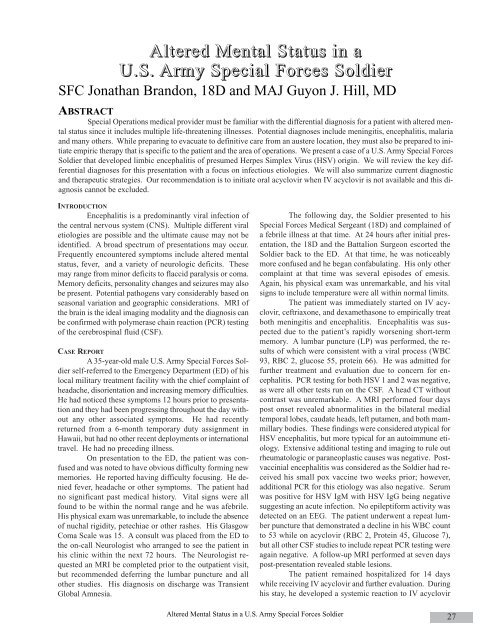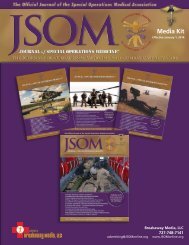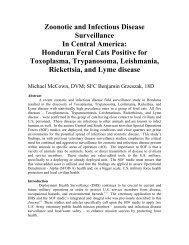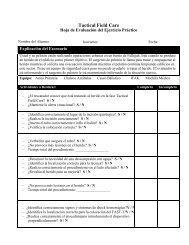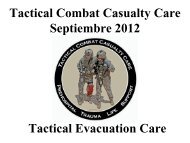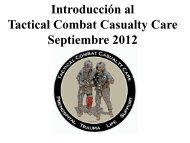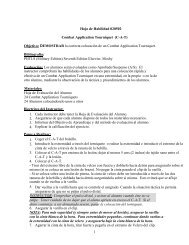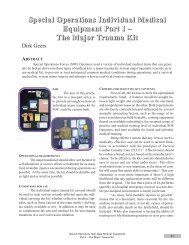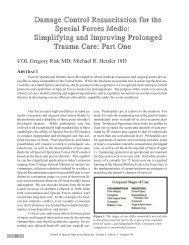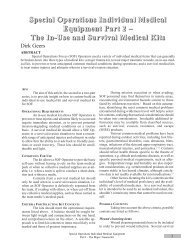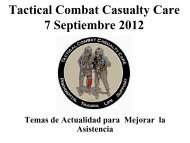Brandon J. Hill G. Altered Mental Status in a U.S. Army Special ...
Brandon J. Hill G. Altered Mental Status in a U.S. Army Special ...
Brandon J. Hill G. Altered Mental Status in a U.S. Army Special ...
Create successful ePaper yourself
Turn your PDF publications into a flip-book with our unique Google optimized e-Paper software.
<strong>Altered</strong> <strong>Mental</strong> <strong>Status</strong> <strong>in</strong> a<br />
U.S. <strong>Army</strong> <strong>Special</strong> Forces Soldier<br />
SFC Jonathan <strong>Brandon</strong>, 18D and MAJ Guyon J. <strong>Hill</strong>, MD<br />
ABSTRACT<br />
<strong>Special</strong> Operations medical provider must be familiar with the differential diagnosis for a patient with altered mental<br />
status s<strong>in</strong>ce it <strong>in</strong>cludes multiple life-threaten<strong>in</strong>g illnesses. Potential diagnoses <strong>in</strong>clude men<strong>in</strong>gitis, encephalitis, malaria<br />
and many others. While prepar<strong>in</strong>g to evacuate to def<strong>in</strong>itive care from an austere location, they must also be prepared to <strong>in</strong>itiate<br />
empiric therapy that is specific to the patient and the area of operations. We present a case of a U.S. <strong>Army</strong> <strong>Special</strong> Forces<br />
Soldier that developed limbic encephalitis of presumed Herpes Simplex Virus (HSV) orig<strong>in</strong>. We will review the key differential<br />
diagnoses for this presentation with a focus on <strong>in</strong>fectious etiologies. We will also summarize current diagnostic<br />
and therapeutic strategies. Our recommendation is to <strong>in</strong>itiate oral acyclovir when IV acyclovir is not available and this diagnosis<br />
cannot be excluded.<br />
INTRODUCTION<br />
Encephalitis is a predom<strong>in</strong>antly viral <strong>in</strong>fection of<br />
the central nervous system (CNS). Multiple different viral<br />
etiologies are possible and the ultimate cause may not be<br />
identified. A broad spectrum of presentations may occur.<br />
Frequently encountered symptoms <strong>in</strong>clude altered mental<br />
status, fever, and a variety of neurologic deficits. These<br />
may range from m<strong>in</strong>or deficits to flaccid paralysis or coma.<br />
Memory deficits, personality changes and seizures may also<br />
be present. Potential pathogens vary considerably based on<br />
seasonal variation and geographic considerations. MRI of<br />
the bra<strong>in</strong> is the ideal imag<strong>in</strong>g modality and the diagnosis can<br />
be confirmed with polymerase cha<strong>in</strong> reaction (PCR) test<strong>in</strong>g<br />
of the cerebrosp<strong>in</strong>al fluid (CSF).<br />
CASE REPORT<br />
A 35-year-old male U.S. <strong>Army</strong> <strong>Special</strong> Forces Soldier<br />
self-referred to the Emergency Department (ED) of his<br />
local military treatment facility with the chief compla<strong>in</strong>t of<br />
headache, disorientation and <strong>in</strong>creas<strong>in</strong>g memory difficulties.<br />
He had noticed these symptoms 12 hours prior to presentation<br />
and they had been progress<strong>in</strong>g throughout the day without<br />
any other associated symptoms. He had recently<br />
returned from a 6-month temporary duty assignment <strong>in</strong><br />
Hawaii, but had no other recent deployments or <strong>in</strong>ternational<br />
travel. He had no preced<strong>in</strong>g illness.<br />
On presentation to the ED, the patient was confused<br />
and was noted to have obvious difficulty form<strong>in</strong>g new<br />
memories. He reported hav<strong>in</strong>g difficulty focus<strong>in</strong>g. He denied<br />
fever, headache or other symptoms. The patient had<br />
no significant past medical history. Vital signs were all<br />
found to be with<strong>in</strong> the normal range and he was afebrile.<br />
His physical exam was unremarkable, to <strong>in</strong>clude the absence<br />
of nuchal rigidity, petechiae or other rashes. His Glasgow<br />
Coma Scale was 15. A consult was placed from the ED to<br />
the on-call Neurologist who arranged to see the patient <strong>in</strong><br />
his cl<strong>in</strong>ic with<strong>in</strong> the next 72 hours. The Neurologist requested<br />
an MRI be completed prior to the outpatient visit,<br />
but recommended deferr<strong>in</strong>g the lumbar puncture and all<br />
other studies. His diagnosis on discharge was Transient<br />
Global Amnesia.<br />
The follow<strong>in</strong>g day, the Soldier presented to his<br />
<strong>Special</strong> Forces Medical Sergeant (18D) and compla<strong>in</strong>ed of<br />
a febrile illness at that time. At 24 hours after <strong>in</strong>itial presentation,<br />
the 18D and the Battalion Surgeon escorted the<br />
Soldier back to the ED. At that time, he was noticeably<br />
more confused and he began confabulat<strong>in</strong>g. His only other<br />
compla<strong>in</strong>t at that time was several episodes of emesis.<br />
Aga<strong>in</strong>, his physical exam was unremarkable, and his vital<br />
signs to <strong>in</strong>clude temperature were all with<strong>in</strong> normal limits.<br />
The patient was immediately started on IV acyclovir,<br />
ceftriaxone, and dexamethasone to empirically treat<br />
both men<strong>in</strong>gitis and encephalitis. Encephalitis was suspected<br />
due to the patient’s rapidly worsen<strong>in</strong>g short-term<br />
memory. A lumbar puncture (LP) was performed, the results<br />
of which were consistent with a viral process (WBC<br />
93, RBC 2, glucose 55, prote<strong>in</strong> 66). He was admitted for<br />
further treatment and evaluation due to concern for encephalitis.<br />
PCR test<strong>in</strong>g for both HSV 1 and 2 was negative,<br />
as were all other tests run on the CSF. A head CT without<br />
contrast was unremarkable. A MRI performed four days<br />
post onset revealed abnormalities <strong>in</strong> the bilateral medial<br />
temporal lobes, caudate heads, left putamen, and both mammillary<br />
bodies. These f<strong>in</strong>d<strong>in</strong>gs were considered atypical for<br />
HSV encephalitis, but more typical for an autoimmune etiology.<br />
Extensive additional test<strong>in</strong>g and imag<strong>in</strong>g to rule out<br />
rheumatologic or paraneoplastic causes was negative. Postvacc<strong>in</strong>ial<br />
encephalitis was considered as the Soldier had received<br />
his small pox vacc<strong>in</strong>e two weeks prior; however,<br />
additional PCR for this etiology was also negative. Serum<br />
was positive for HSV IgM with HSV IgG be<strong>in</strong>g negative<br />
suggest<strong>in</strong>g an acute <strong>in</strong>fection. No epileptiform activity was<br />
detected on an EEG. The patient underwent a repeat lumber<br />
puncture that demonstrated a decl<strong>in</strong>e <strong>in</strong> his WBC count<br />
to 53 while on acyclovir (RBC 2, Prote<strong>in</strong> 45, Glucose 7),<br />
but all other CSF studies to <strong>in</strong>clude repeat PCR test<strong>in</strong>g were<br />
aga<strong>in</strong> negative. A follow-up MRI performed at seven days<br />
post-presentation revealed stable lesions.<br />
The patient rema<strong>in</strong>ed hospitalized for 14 days<br />
while receiv<strong>in</strong>g IV acyclovir and further evaluation. Dur<strong>in</strong>g<br />
his stay, he developed a systemic reaction to IV acyclovir<br />
<strong>Altered</strong> <strong>Mental</strong> <strong>Status</strong> <strong>in</strong> a U.S. <strong>Army</strong> <strong>Special</strong> Forces Soldier 27
that manifested as a diffuse erythematous rash. Due to the<br />
presumption of HSV encephalitis, the decision was made to<br />
cont<strong>in</strong>ue the medication and the addition of diphenhydram<strong>in</strong>e<br />
reduced his symptoms dramatically. His anterograde<br />
amnesia mildly improved dur<strong>in</strong>g this time. He was<br />
discharged and received a total of 21 days IV acyclovir with<br />
improvement <strong>in</strong> both cl<strong>in</strong>ical status and laboratory values.<br />
The patient did not display seizure activity at any time. The<br />
only other symptom he reported was occasional moderate<br />
headaches, which were relieved with either ibuprofen or<br />
acetam<strong>in</strong>ophen. The patient scored 28/30 on a m<strong>in</strong>i-mental<br />
status exam eight days after discharge. The f<strong>in</strong>al diagnosis<br />
was limbic encephalitis of HSV orig<strong>in</strong> although PCR was<br />
negative on both occasions. This patient was presumed to<br />
have HSV encephalitis due to his improvement while on acyclovir.<br />
The possibility that the patient’s encephalitis was<br />
caused by a herpes virus other than HSV 1 or 2 also exists<br />
(e.g., human herpes virus 6 or HHV 6).<br />
Follow-on care was performed on an outpatient<br />
basis that <strong>in</strong>cluded cognitive rehabilitation at Stanford University<br />
for four months. He was returned to full duty n<strong>in</strong>e<br />
months post onset with m<strong>in</strong>imal neurological sequelae. He<br />
cont<strong>in</strong>ues to function on an Operational Detachment - Alpha<br />
without any duty restrictions.<br />
DISCUSSION<br />
Herpes Simplex Virus is the most common cause<br />
of severe sporadic encephalitis <strong>in</strong> North America and <strong>in</strong> the<br />
world. Although it has the highest mortality rate, it is also<br />
the most treatable form of encephalitis. 1,2,3 It is known for<br />
the serious, often long-term, neurological sequelae that affect<br />
many survivors even after receiv<strong>in</strong>g treatment. However,<br />
prompt recognition and early treatment can still provide<br />
good patient outcomes. Mortality reaches 70% <strong>in</strong> untreated<br />
cases of HSV encephalitis, but decreases to 19-28% with appropriate<br />
diagnosis and treatment. 4,5<br />
Primary signs and symptoms may <strong>in</strong>clude fever,<br />
headache, nuchal rigidity, focal neurologic deficits or memory<br />
loss. <strong>Altered</strong> mental status or seizure activity may also<br />
be present. <strong>Altered</strong> mental status may refer to many alterations<br />
<strong>in</strong> bra<strong>in</strong> function; these effects can range from m<strong>in</strong>imal<br />
to encephalopathy and coma. They may <strong>in</strong>clude:<br />
confusion, loss of orientation, delirium, lethargy, emotional<br />
lability, psychomotor retardation and others. Onset can be<br />
acute, or present with the prodrome of a flu-like illness. This<br />
patient’s presentation is unusual <strong>in</strong> that he never exhibited<br />
any focal neurologic signs or seizures. He compla<strong>in</strong>ed of<br />
subjective fever upon his second presentation, but did not<br />
exhibit objective fever prior to admission to the hospital. It<br />
is unknown if he was tak<strong>in</strong>g antipyretics due to his difficulties<br />
with short-term recall at that po<strong>in</strong>t.<br />
The differential diagnosis for this presentation is<br />
extensive, especially with<strong>in</strong> the spectrum of medic<strong>in</strong>e <strong>in</strong> <strong>Special</strong><br />
Operations where Soldiers travel throughout the world.<br />
A thorough travel and exposure history must be elicited.<br />
Numerous <strong>in</strong>fectious etiologies for viral encephalitis exist<br />
and are often endemic to specific regions or show seasonal<br />
variation. Many other viruses can cause encephalitis and<br />
their cl<strong>in</strong>ical presentation is the same as HSV encephalitis.<br />
Most <strong>in</strong>fections by viruses that cause encephalitis are subcl<strong>in</strong>ical,<br />
and encephalitis from HSV is itself a rare complication.<br />
These <strong>in</strong>clude the St. Louis encephalitis, West Nile<br />
encephalitis, Eastern Equ<strong>in</strong>e encephalitis, Japanese encephalitis<br />
(<strong>in</strong> Asia) or encephalitis from other herpes viruses.<br />
Men<strong>in</strong>gitis, especially if caused by tuberculosis, may have a<br />
similar presentation. Malaria must be considered <strong>in</strong> a patient<br />
with history of potential exposure, even with appropriate<br />
prophylaxis. Other differential diagnoses <strong>in</strong>clude<br />
subdural hematoma or empyema, <strong>in</strong>tracranial neoplasms<br />
(primary or secondary), vasculitis, bra<strong>in</strong> abscess, rabies, and<br />
drug-<strong>in</strong>duced encephalopathy.<br />
HSV appears to <strong>in</strong>fect cerebral tissue through the<br />
trigem<strong>in</strong>al nerve or the olfactory route, but may also develop<br />
secondarily to viremia. Infection can result from a primary<br />
HSV <strong>in</strong>fection of the oropharynx, a recurrent HSV <strong>in</strong>fection,<br />
or without any previously identified HSV <strong>in</strong>fection as <strong>in</strong> this<br />
patient. The predom<strong>in</strong>ant result is hemorrhagic necrosis and<br />
petechial hemorrhage <strong>in</strong> the <strong>in</strong>ferior and medial temporal<br />
lobes and portions of the frontal lobes. Either HSV-1 or<br />
HSV-2 can cause encephalitis <strong>in</strong> the neonatal period, but<br />
HSV-2 is more common and is usually caused by contact<br />
with <strong>in</strong>fected maternal secretions dur<strong>in</strong>g birth. HSV-1 is the<br />
predom<strong>in</strong>ant cause of HSV encephalitis <strong>in</strong> the vast majority<br />
patients past this period.<br />
PCR test<strong>in</strong>g of the CSF is rapid and highly sensitive<br />
and specific, and has become the standard of diagnosis for<br />
HSV encephalitis. 6,7 PCR should be positive with<strong>in</strong> 24 hours<br />
of onset, with a sensitivity of 98% and a specificity of 94-<br />
100%. It rema<strong>in</strong>s positive throughout the first seven days<br />
of antiviral therapy. 3,7 Cranial CT scan may demonstrate<br />
temporal lobe hypodensity, but only has an early sensitivity<br />
of 50%. 3 CT imag<strong>in</strong>g may be useful to rule out other differentials,<br />
such as space-occupy<strong>in</strong>g lesions. MRI is the most<br />
sensitive and specific imag<strong>in</strong>g modality for HSV encephalitis<br />
and can help expedite the diagnosis. It shows abnormalities<br />
<strong>in</strong> almost all cases, especially when conducted early <strong>in</strong><br />
the disease process. It frequently shows very characteristic<br />
temporal lobe lesions. Bra<strong>in</strong> biopsy should be considered<br />
for patients with a negative PCR that still present with a high<br />
suspicion for HSV encephalitis. 2,3 Regardless of the efficacy<br />
or availability of laboratory test<strong>in</strong>g or imag<strong>in</strong>g, antiviral<br />
chemotherapy must not be delayed.<br />
Intravenous acyclovir is the standard for treatment<br />
of HSV encephalitis. It must be <strong>in</strong>itiated as soon as Herpes<br />
encephalitis is cl<strong>in</strong>ically suspected to maximally reduce mortality<br />
and improve neurologic outcomes <strong>in</strong> survivors. 2,3 This<br />
is especially true <strong>in</strong> cl<strong>in</strong>ical environments that are more austere<br />
where MRI and CSF studies aren’t possible and there<br />
may be delays <strong>in</strong> def<strong>in</strong>itive diagnoses. The patient’s age and<br />
state of consciousness at the time of <strong>in</strong>itial therapy greatly<br />
impact the mortality rate as well as morbidity. Most patients<br />
who survive will still have some degree of neurological dysfunction.<br />
The normal duration of IV therapy is 14-21 days<br />
and the drug is generally well tolerated. Although this pa-<br />
28<br />
Journal of <strong>Special</strong> Operations Medic<strong>in</strong>e Volume 11, Edition 1 / W<strong>in</strong>ter 11
tient exhibited a systemic reaction, it was well controlled<br />
with the addition of diphenhydram<strong>in</strong>e and he was able to cont<strong>in</strong>ue<br />
therapy.<br />
Although IV acyclovir is rarely carried by SOF<br />
medical providers, oral acyclovir is more readily available.<br />
Oral acyclovir has a bioavailability of only 10%-30%. 8,9 In<br />
our op<strong>in</strong>ion, however, oral acyclovir should be considered<br />
until the appropriate treatment and diagnosis can be provided<br />
when encephalitis is suspected. We were only able to f<strong>in</strong>d<br />
one case report <strong>in</strong> the literature document<strong>in</strong>g the treatment<br />
of suspected HSV encephalitis with oral acyclovir. 8 No trials<br />
were found. This patient from India, however, responded<br />
dramatically to a 10-day oral course even when it was started<br />
on the 6th day of symptoms. An oral preparation was used<br />
<strong>in</strong> that child due to the parent’s <strong>in</strong>ability to afford the IV medication.<br />
In addition, add<strong>in</strong>g PO or IV acyclovir to the treatment<br />
protocol for men<strong>in</strong>gitis is reasonable if the means are<br />
not available to narrow the diagnosis.<br />
This patient had an excellent outcome despite develop<strong>in</strong>g<br />
a potentially devastat<strong>in</strong>g disease. His presentation<br />
was highly unusual <strong>in</strong> that his only objective symptom at the<br />
time treatment was severe difficulty with short-term memory.<br />
The vast majority of patients with encephalitis will be<br />
febrile. It is difficult to estimate the degree to which he<br />
would have manifested other typical symptoms such as fever,<br />
focal neurologic deficits, seizures, or other forms of altered<br />
mental status if he had not received treatment <strong>in</strong> the early<br />
stages of his disease process. However, it is highly probable<br />
that his outcome was greatly improved with the prompt and<br />
empiric <strong>in</strong>itiation of acyclovir. Acyclovir is the only treatment<br />
option for HSV encephalitis. As this is the only treatable<br />
form of encephalitis, any suspected encephalitis should<br />
be treated empirically with acyclovir. The potential differential<br />
diagnoses for a patient with altered mental status are<br />
myriad and may <strong>in</strong>clude multiple <strong>in</strong>fectious and non-<strong>in</strong>fectious<br />
causes. For this reason, a thorough consideration of the<br />
area of operations, the patient’s risk factors, and potential<br />
consultation with expert medical providers can help taylor<br />
therapy and improve patient outcomes. If the patient presents<br />
<strong>in</strong> an austere area, it may be necessary to treat empirically<br />
for more than one possible disease (e.g., encephalitis and<br />
men<strong>in</strong>gitis) by comb<strong>in</strong><strong>in</strong>g acyclovir with other medications<br />
while the patient is be<strong>in</strong>g evacuated for further evaluation<br />
and treatment.<br />
CONCLUSION<br />
HSV Encephalitis is a potentially catastrophic disease<br />
that should be considered <strong>in</strong> any patient altered mental<br />
status, especially if they present with fever. The prognosis<br />
for a patient with this disease can be dramatically improved<br />
with prompt recognition and the <strong>in</strong>itiation of IV acyclovir.<br />
Acyclovir should be started immediately and cont<strong>in</strong>ued until<br />
the diagnosis can be ruled <strong>in</strong> or excluded. When IV acyclovir<br />
is not available, we recommend start<strong>in</strong>g PO acyclovir while<br />
the patient is be<strong>in</strong>g evacuated to def<strong>in</strong>itive care. Recognition<br />
of this disease, and <strong>in</strong>itiat<strong>in</strong>g treatment are with<strong>in</strong> the<br />
scope of practice for the SOF Medic. Based on the potential<br />
mortality and morbidity associated with this diagnosis, this<br />
disease should receive <strong>in</strong>creased emphasis <strong>in</strong> tra<strong>in</strong><strong>in</strong>g and<br />
certification programs for the SOF Medic.<br />
REFERENCES<br />
1. Carpenter, C., Griggs, R., & Loscalzo, J. (2001). Cecil Essetials<br />
of Medic<strong>in</strong>e (5th Ed.). Philadelphia, WB Saunders Co.,<br />
p. 778-779.<br />
2. T<strong>in</strong>t<strong>in</strong>alli, J. (2004). Emergency Medic<strong>in</strong>e: A Comprehensive<br />
Study Guide (6th Ed.). New York, McGraw-<strong>Hill</strong>, p. 920-921,<br />
1445.<br />
3. Kle<strong>in</strong>, R.S. (2010, October 1). Herpes Simplex Virus Type 1<br />
Encephalitis. Ed. M.S. Hirsch. Retrieved January 6, 2011 from<br />
UpToDate website at http://www.uptodate.com.<br />
4. Whitley, RJ, Alford, CA, Hirsch, MS, et al. (1986). Vidarab<strong>in</strong>e<br />
versus Acyclovir Therapy <strong>in</strong> Herpes Encephalitis. New<br />
England Journal of Medic<strong>in</strong>e, 314:144.<br />
5. Sköldenberg, B, Forsgren, M, Alestig, K, et al. (1984). Acyclovir<br />
versus Vidarab<strong>in</strong>e <strong>in</strong> Herpes Simplex Encephalitis.<br />
Randomised Multicentre Study <strong>in</strong> Consecutive Swedish Patients.<br />
Lancet, 2:707.<br />
6. Braunwald, E., Fauci, A., Kasper, D., et al. (2001). Harrison’s<br />
Pr<strong>in</strong>ciples of Internal Medic<strong>in</strong>e (15th Ed.). New York, Mc-<br />
Graw-<strong>Hill</strong>, p. 1103.<br />
7. Caliendo, A.M. (2007, June 1). PCR Test<strong>in</strong>g for the Diagnosis<br />
of Herpes Simplex Virus Encephalitis. Ed. M.S. Hirsch. Retrieved<br />
January 6, 2011 from the UpToDate website at<br />
http://www.uptodate.com.<br />
8. Awasthi, S., Nara<strong>in</strong>, S., Thavnani, H., et al. (1995). Oral Acyclovir<br />
<strong>in</strong> Treatment of Suspected Herpes Simplex Encephalitis.<br />
Indian Pediatrics, 32: 485-487.<br />
9. Wonsiewicz, M., & Morriss, J. (2001). Goodman and<br />
Gilman’s The Pharmacological Basis of Therapeutics (10th<br />
Ed.). New York, McGraw-<strong>Hill</strong>, p. 1317-1321.<br />
SFC Jonathan W. <strong>Brandon</strong> is a <strong>Special</strong> Forces Medical Sergeant and Combat Diver Medical Technician.<br />
He is currently serv<strong>in</strong>g as an <strong>in</strong>structor at the <strong>Special</strong> Warfare Medical Group, and has eight years of active<br />
duty service. His deployments <strong>in</strong>clude: Operation Endur<strong>in</strong>g Freedom – Afghanistan, Operation Iraqi<br />
Freedom, and Operation Balance Style - Sri Lanka.<br />
MAJ Guyon <strong>Hill</strong>, M.D. is a board certified Emergency Physician, Flight Surgeon and Div<strong>in</strong>g Medical Officer<br />
assigned to the U.S. <strong>Army</strong> J.F.K <strong>Special</strong> Warfare Center and School. He previously served as the Battalion<br />
Surgeon for 3rd Battalion, 1st <strong>Special</strong> Forces Group (Airborne). He has deployed <strong>in</strong> support of<br />
Operation Endur<strong>in</strong>g Freedom-Afghanistan and Operation Iraqi Freedom.<br />
<strong>Altered</strong> <strong>Mental</strong> <strong>Status</strong> <strong>in</strong> a U.S. <strong>Army</strong> <strong>Special</strong> Forces Soldier 29


